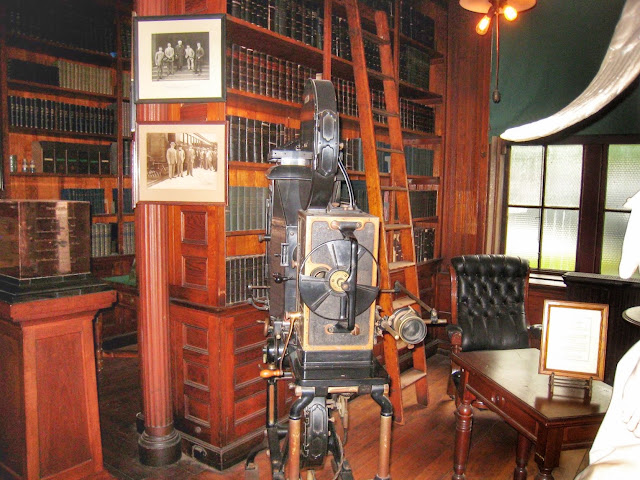Genius at Work
ON THE HISTORY HIGHWAY, Day 39:Parsippany, NJ to Danbury, CT
In our quest to explore anything and everything historical on this trip, today we stopped at the Thomas Edison National Historical Park in West Orange and immersed ourselves in industrial history. Only rarely does an inventive mind of Edison's caliber come into the world. Like Leonardo da Vinci, Edison lacked a formal education, having attended only a few months of school. This left him free to channel his curiosity and creative genius in many different directions rather than one specialized area.
Thanks to the generosity of Edison's heirs, his research laboratory complex and West Orange home are now part of the National Park Service system. Both the labs and house were preserved with almost all their contents intact, allowing visitors to see them as they were when Edison himself lived and worked there. In fact, NPS archivists have inventoried more than 400,000 artifacts on the Edison properties, one of the largest museum collections in the system. Included are 48,000 sound recordings and Edison's personal library of 10,000 rare books.
Thanks to the generosity of Edison's heirs, his research laboratory complex and West Orange home are now part of the National Park Service system. Both the labs and house were preserved with almost all their contents intact, allowing visitors to see them as they were when Edison himself lived and worked there. In fact, NPS archivists have inventoried more than 400,000 artifacts on the Edison properties, one of the largest museum collections in the system. Included are 48,000 sound recordings and Edison's personal library of 10,000 rare books.
space
On our tour of the chemistry lab (pictured above), the park ranger guide speculated that today OSHA would probably padlock the doors of all Edison's laboratories, but at the time, he was on the cutting edge of development, founding what is widely credited as the first industrial research laboratory. The complex included a three-story main complex with machine shops, specialized experimental rooms, a power plant, and Edison's large office and library. Separate one-story buildings housed labs for chemistry, physics, and metallurgy.
On our tour of the chemistry lab (pictured above), the park ranger guide speculated that today OSHA would probably padlock the doors of all Edison's laboratories, but at the time, he was on the cutting edge of development, founding what is widely credited as the first industrial research laboratory. The complex included a three-story main complex with machine shops, specialized experimental rooms, a power plant, and Edison's large office and library. Separate one-story buildings housed labs for chemistry, physics, and metallurgy.
space
Like da Vinci, Edison was fond of taking power naps throughout the long days and often evenings he spent working at his labs. Rather than resting his head on his desk, however, one of the alcoves in his three-story office/library was fitted with just the equipment he needed for a bit of polyphasic sleep.
space
 |
| Edison's office |
space
 |
| Edison's office |
space
 |
| One of Edison's many phonographs |
Edison was also a shrewd entrepreneur, founding dozens of companies to manufacture and distribute his inventions. "I always invented to obtain money to go on inventing," he said. Edison was still working at his labs, experimenting with new ideas until his death at age 84. One of his last projects was undertaken on behalf of his friends Henry Ford and Harvey Firestone, who asked him to come up with an alternate source of rubber so they could escape the uncertainty of dependence on foreign sources. A sample of the 15-ft goldenrod strain he developed for this project is on exhibit in his chemistry lab, just where he left it.
space
In 1886, Edison bought a 29-room brick and wood mansion in an exclusive West Orange neighborhood. The house had been built by an office clerk, who spared no expense in the construction and furnishing of his splendid home. After all, why should he pinch pennies? All the costs were paid by money he embezzled from his employer, a bottomless well for this enterprising fellow. When his misdeeds were discovered, Edison stumbled upon a bargain, purchasing the estate, complete with a greenhouse and several other outbuildings, for the fire sale price of $125,000, including all the furnishings. Guided tours of the home are provided by knowledgeable rangers, and since this is National Park Week, all admissions were free.
space
After our pleasant three-hour visit to the Edison site, we had to negotiate our way across metropolitan New York to western Connecticut. We expected to drive north of the city, but due to some construction and road closures, we suddenly realized that by blindly following the GPS, we were headed right into the mouth of the beast.
space
After our pleasant three-hour visit to the Edison site, we had to negotiate our way across metropolitan New York to western Connecticut. We expected to drive north of the city, but due to some construction and road closures, we suddenly realized that by blindly following the GPS, we were headed right into the mouth of the beast.
space space
Thankfully, it was Sunday or theoretically the traffic could have been heavier. However, a steady rain more than made up for the lack of volume. We sat in line for an hour negotiating the final mile to the toll booth for the George Washington Bridge. In a risky game of odds-playing, the lane darters constantly flitted from one lane to another, increasing the annoyance factor and the delay. The stop-and-go-and-stop-and-stop traffic didn't end until we were well beyond New York City and almost to Connecticut, but as the traffic became lighter, the rain grew heavier. Finally, we completed our 78-mile trip in a little more than four hours. Tomorrow we hope to hook up with a cousin who lives on the Connecticut coast and to stay out of rainy traffic.
space space
SUNDAY, 22 APRIL 2012






